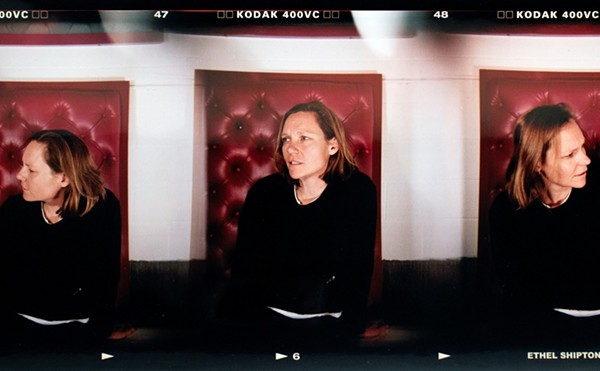
The titular image is a large photograph of the view from an airplane seat. Not just the overhead view of the sprawl of landscape you’re flying over, but the interior architecture of the window itself—on which the word “Doubt” is written in Sharpie—and a couple of seats. It’s really good, this image, very specific. It locates us not just in the sky, but conveyed by something at once miraculous, mundane and manmade.
“Doubt” is the first of four stops on a multi-locational “pilgrimage” exhibition of Chris Sauter’s recent work. In the cell phone audio tour, Sauter describes the overall project as “a large body of work about the relationship between science and religion,” then gets to a catchy hook of personal perspective by continuing, “In the United States, the rift between the understanding of science and religious dogma is ever widening, affecting the political, educational and medical system. An exploration in acknowledgment of the history and connections between the two seems more vital than ever.” (Italics mine).
Sauter the artist is keenly precise and likewise a meticulous composer of language. There’s a lot of weight in his choice of verb in the above: seems. Much of the show’s authority arises from Sauter’s myriad suggestions, rather than an egoistic investment in “proving” anything. Among other fascinating premises, he suggests that: (a) cosmology is wired right into our brains, and that (b) our brains make the cosmos seem understandable.
Between those two suggestions lies a multiverse of nuance and mystery, just as between the doctrines/demands of religion and science. Elsewhere in the curatorial literature, Sauter describes the science-religion divide as a false dichotomy.
This is presented with graphic wit in three floor-mounted felt sculptures recalling altar decorations from 1970s religion (Sauter was raised Lutheran). But in place of the dove and grapes, the images of brains and particles reify brain science and the Higgs Boson; does a collusion of particle physics and neurology amount to a kind of physical religion? What animates our human machinery? What fills the dark matter of physical space, the holes of our collective yearnings?
Sauter takes on a lot of ideology here, but the individual pieces feel cohesive rather than an overreach. And there’s so much satisfying tactile presence. Witness the sculpture Stalagmites for Nicolas Steno (2013). He’s built up a stalagmite of candle wax growing up from an open Bible. There’s a wick at the top; the wax still comprises a functioning candle. Sauter equips his work with so many fruitful associations. The structurality of the wax stalagmite reminded me of the stalagmites at Natural Bridge Caverns, where as a child I was instructed to differentiate stalagmites and stalactites with the mnemonic, “The stalagmite MIGHT reach heaven.” But that’s my association; no matter who you are, you’ll have mighty ones of your own. From the wax, there’s a smell element, too.
Maybe my favorite moment in this chapter of the pilgrimage is Soft Focus, (2013) a stark, elegant photograph of a space capsule mid-orbit over a purple horizon, with fingerprints all over the acrylic frame. I’d like to know what the capsule actually is, its date and provenance, but it ultimately matters less than the wonder and curiosity it evokes, and remembers. Childhood nostalgia in Sauter’s hands is elevated past jokey cliche, and goes right to the origins of the American mythmaking mind. The kind of technology of NASA in the ’70s; we’ve got our grubby hands on outer space.
I was a big fan of The Known Universe (Childhood Bedroom), (2007), an enclosed environmental installation for which he constructed a dreamy, life-size replica of his boyhood bedroom in Boerne. It’s got dresser drawers, a single bed, the Time/Life “Mysteries of the Unknown” book series and the song “Under the Milky Way Tonight” by The Church on deck.
With “Doubt,” it feels as though he’s taken that nucleus of an atom of an idea and blown it up, taken a longtime viewer from the known universe of childhood to the shattered orthodoxies of fortysomething. This is an aside, really; coming fresh to Sauter in this pilgrimage is as good a way to start appreciating him as anything he’s done before.
The next three stops on the pilgrimage are at the Blue Star Contemporary Art Museum (which opened December 5), Fl!ght (Dec 14) and St. Mark’s Episcopal Church (Jan 4). From there, I can imagine many environments Sauter’s work could inhabit: a natural history museum, a planetarium, a space station, outer space itself.
Chris Sauter: Doubt
Free
9am-5pm Mon-Sat; 11am-4pm Sun
Southwest School of Art - Navarro Campus
300 Augusta
(210) 224-1848
swschool.org
Through Feb 2















